

New Players Think You Have To Read Music To Play Guitar. You Don't!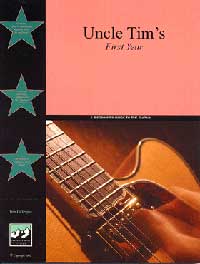
Nothing could be farther from the truth. In fact if you do not learn to play songs by reading musical notation, you really don't need it at all.
Although there are benefits to being able to read musical notation, most guitarists use tablature or plain old chord charts to learn songs.
Uncle Tim's First Year does include notation, but it features pictures and text because it makes it so easy. And you can use the information the same day, not later when you learn a new language, which notation is!
For $15, you can put this all to rest right now. Pick up a copy today.
eBooks are delivered instantly!
Sometimes, particularly when you deal with certain people, you find yourself staring at musical notation in the hopes of communicating complex concepts. Although most guitarists do not use notation for typical channels of communication, jazz and classical guitarists are exceptions to this general rule.
This is the case with this month's guest column on timing. And it makes a great deal of sense too. After all we are focusing on timing, and musical notation excels at providing a sense of timing. Even though notation is better at describing these issues than other forms of writing, it still leaves much to be desired. In fact without hearing the music, it can be somewhat difficult to get the feel of the line. If you want to see what I mean, try playing the examples first without hearing the actual riffs. Once you hear them, it will probably help you to understand how they are suppose to sound.
So we might as well use this as an opportunity to once again review some common symbols of notation.
Beats and Measures

![]()
![]() In this example
we have 4/4 time, we can assign values to notes and plan how many of
these notes we can get in each measure.
In this example
we have 4/4 time, we can assign values to notes and plan how many of
these notes we can get in each measure.
In this example you can see we have quarter notes and they receive four beats per measure. Here are the typical notes and their values.

![]()
![]()
![]()
![]()
![]()
![]()
![]()
![]()
![]()

Time signatures can be very simple (as in the case of common time) or they can be more sophisticated Another very common time signature is 3/4 time. Here is what the signature looks like using quarter notes, 3/4 and 4/4 time.
Also notice that two examples have dotted quarter notes. Each quarter note gets one beat and gets another half beat from the dot.
This means two dotted quarter notes equals three quarter notes. So two dotted notes in 3/4 time fills out a measure. 3/4 time has three quarter notes per measure.
The Physical Space
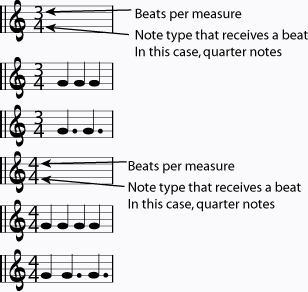 It might help to have played the examples in Bob's guest column before
really analyzing the material. It will give you some insight into how
to think about it. Basically all of these rifts are cut out of the scale
of C major. When you create a lead you are actually using a scale, selecting
some notes from it, and applying them in some unique sequence to craft
a lead statement. The hope is, someone else will think it was clever
too!
It might help to have played the examples in Bob's guest column before
really analyzing the material. It will give you some insight into how
to think about it. Basically all of these rifts are cut out of the scale
of C major. When you create a lead you are actually using a scale, selecting
some notes from it, and applying them in some unique sequence to craft
a lead statement. The hope is, someone else will think it was clever
too!
There is the point in development when a guitarist learns to use scales to create leads. Not much is written about this step. We often times hear about how important scales are to playing, without talking about how you actually use them and turn them into musical lead statements. But that is what every successful lead guitarist has to do. We are going to identify how this relates to the key of C and then identify the exact scale fragment in which the lead is carved from. By examining the structure of a lead and identifying it with the exact place within the physical signature we cal lock this lead into our existing base of information. Once it is put in place, all of our existing tricks within the framework should be available for experimentation as well as the wealth of history and background you may have already developed when working out of the diatonic signature.
In addition to that, any new trick you might pick up can be mentally catalogued and added to your base of information. Then it will be available for any future jam session or song writing activity you may find yourself in. Making a connection with the diatonic signature and a real song or rift application can drive home the true big picture of how this can shape your understanding of music.
In a sense, these new parts are already a part of the diatonic framework, now you just have to become aware of them and try to use them. I like to make sure we remember to look at this information as a part of the whole key so we get the maximum benefit when working with it. The more you know, the more you can do!
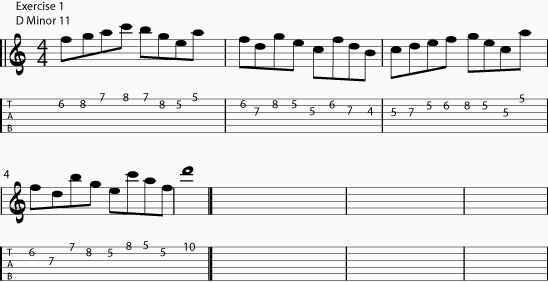

 Exercise
number 1 is basically a C major fragment using only three strings.
The actual scale is shown to the right, the notes in the riff are on
the left. Notice the full scale fragment is one we have seen many times
before. Now we are just working within a limited area and we are choosing
the sequence of notes very carefully.
Exercise
number 1 is basically a C major fragment using only three strings.
The actual scale is shown to the right, the notes in the riff are on
the left. Notice the full scale fragment is one we have seen many times
before. Now we are just working within a limited area and we are choosing
the sequence of notes very carefully.
In fact this lead is shaped by staying in a tight area and moving short distances. The same notes are used multiple times while crafting a flowing statement and climbing to tonic as a means of bringing the run to an end.
To play the notes within the time frame you will have to work out the exact picking path using upstrokes and downstrokes. Otherwise you will find it difficult to be in position on time.
Listen to exercise 1 |
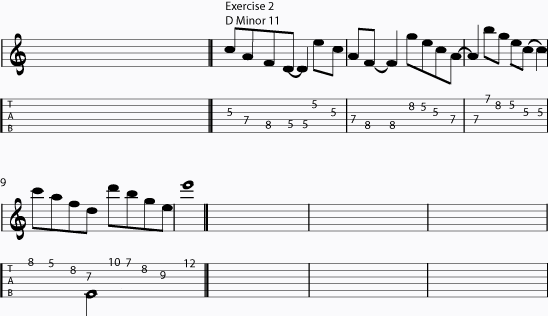

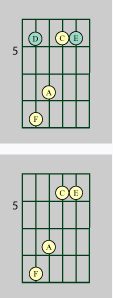 Exercise
number 2 is contained within another C major fragment. This run
also has the complication of including the D and E notes on the high
E string. This notes requires a big adjustment to left hand position
while maintaining the correct timing.
Exercise
number 2 is contained within another C major fragment. This run
also has the complication of including the D and E notes on the high
E string. This notes requires a big adjustment to left hand position
while maintaining the correct timing.
The run starts with the F major chord form shown to the right (yellow notes). The progression then changes from C, A, F, D to E, C, A, F (which is an F major 7 chord). I play this lead by barring the C and the E notes. If you start this lead by using these forms, you will quickly see how to play it. If you are experiencing any fatigue, it may show up in the C note if you play this by barring it. The index finger can get a little sloppy after a good workout and you may start to hear some buzz when you barre these notes. Notice how this lead works both down and up the octave and finally ends with the high E note.
Listen to exercise 2 |
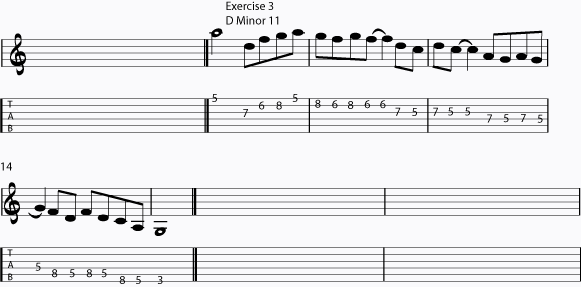
 Exercise
number 3. This run occupies the same physical space on the fretboard,
but it is quite different. This run works downward in pitch, ending
with the G note on the low E string. Although you can play this run
using different note strategies, this strategy provides the best chance
of having your hand in position to be able to show up on time.
Exercise
number 3. This run occupies the same physical space on the fretboard,
but it is quite different. This run works downward in pitch, ending
with the G note on the low E string. Although you can play this run
using different note strategies, this strategy provides the best chance
of having your hand in position to be able to show up on time.
I experimented with using the F note on the D string, but it made it very hard to hit the C note on the eighth fret on the low E string. You could restructure this lead to completely avoid the C note on the low E string, but that is not how Bob plays it and he injects that little slide at the end going from A to G. So there is a very specific path you probably need to use to play this correctly and be on time. In addition you also have to pay close attention to your upstrokes and downstrokes to get the picking correct. Playing scales and developing your ability to control the pick is essential to be able to do this correctly. All of these skills work together to allow you to play these more intense parts. The faster and more intricate the piece, the more it depends on proper technique to help you play things correctly.
Listen to exercise 3 |

 Exercise
number 4. This run is trickier than it looks. It starts with a hammer
on, using the E and F notes. Hitting the fourth note on time makes this
run distinct. It also makes it quite demanding to play on time. The
entire run is made up of repeating the statement three times.
Exercise
number 4. This run is trickier than it looks. It starts with a hammer
on, using the E and F notes. Hitting the fourth note on time makes this
run distinct. It also makes it quite demanding to play on time. The
entire run is made up of repeating the statement three times.
I find that I must barre the G, C and E notes on the fifth fret if I am going to stay on time. The barre creates a problem of pressure and control but it solves the speed issue. The hammer on is the first thing to go south once fatigue sets in. I suggest learning this and taking a short break and then honing the run.
Try this on both an electric and an acoustic guitar. All of these runs are suitable for acoustic guitars, since none of them climb any higher than the twelfth fret. The problem is applying enough pressure to be able to play this on an acoustic. This adds another layer of complexity. Start with the acoustic and move to the electric. It will be easier that way.
Listen to exercise 4 |

 Exercise
number 5 is the best run of the bunch. As Bob was showing this to
me, he was trying to figure out how he could work this into a few songs
and a live performance that night.
Exercise
number 5 is the best run of the bunch. As Bob was showing this to
me, he was trying to figure out how he could work this into a few songs
and a live performance that night.
Bob works the run up to a high point by anchoring on the D note (seventh fret, G string) and climbing one note at a time while mixing it in with the anchor note. He then switches to a single note run, climbs to the D note on the high E string and descends down to the G note on the D string. This is a fun run to play.
Notice that there is quite a bit of movement in a confined space. There are a total of nine different notes used and a total of 29 total notes in the run. That means that on average, each note was played three times. Obviously the D note (anchor) was used more than some of the others. But the point is this run made heavy use of a very confined area and the sound of the run was determined by this intense combinations of these nine notes.
Notice that all of the notes in each run were in the key of C major / A minor. These runs all live totally inside the diatonic signature. In fact they are just more examples of the many runs contained inside this signature of notes.
And now, once you know these runs, you can file them away in your bag of tricks, and play them in any key, whenever you think they would make a nice addition to a song. If you play them every day for a month, you may not even recognize them after a while. I tend to change things slightly and add some of my own feeling to the run after playing it for any length of time. I might even break some piece off and form a secondary matching run that I can play against the original run. Or I might just keep it intact and play it faithfully. Remember these were developed as exercises, so bending them into a new shape is part of the process.
Listen to exercise 5 |
Practicing
Here are a few considerations when approaching this for the first time.
1. First of all just play through the first run and get familiar with the notes. Do this a few times and try not to worry about memorizing this just yet. Play them and notice the notes used and how the run move from section to section.
2. Listen to the run. Focus on the beginning part and see if you can mimic it. From here people use different strategies to learn something. I usually try to learn the beginning of the run and see if I can mentally get inside the lick. Many times I can piece it together without reading the entire line, other times I have to go over it slowly.
3. Once you get the general feeling of the line, take it apart by focusing on the different segments and isolating the moves. Link them up and polish the pieces.
4. As you begin to link the pieces together into a chain of notes, you will have to pay particular attention to exactly what fingers you use to play this. If you have bad technique with finger strategies, this one will present some problems. If you base this lead using the finger strategies we have discussed in past issues, you will probably be able to adapt to this right away. It is very similar.
5. Pay very close attention to your picking hand path. There is one specific path that works better for me than all the others I tried. Your favored paths may be different than mine, so just pay attention to how you pick everything. I found I had to carefully monitor my downstrokes and upstrokes to find an efficient path.
These runs are medium intensity. You should expect to have to work
a little to play these intricate lines.